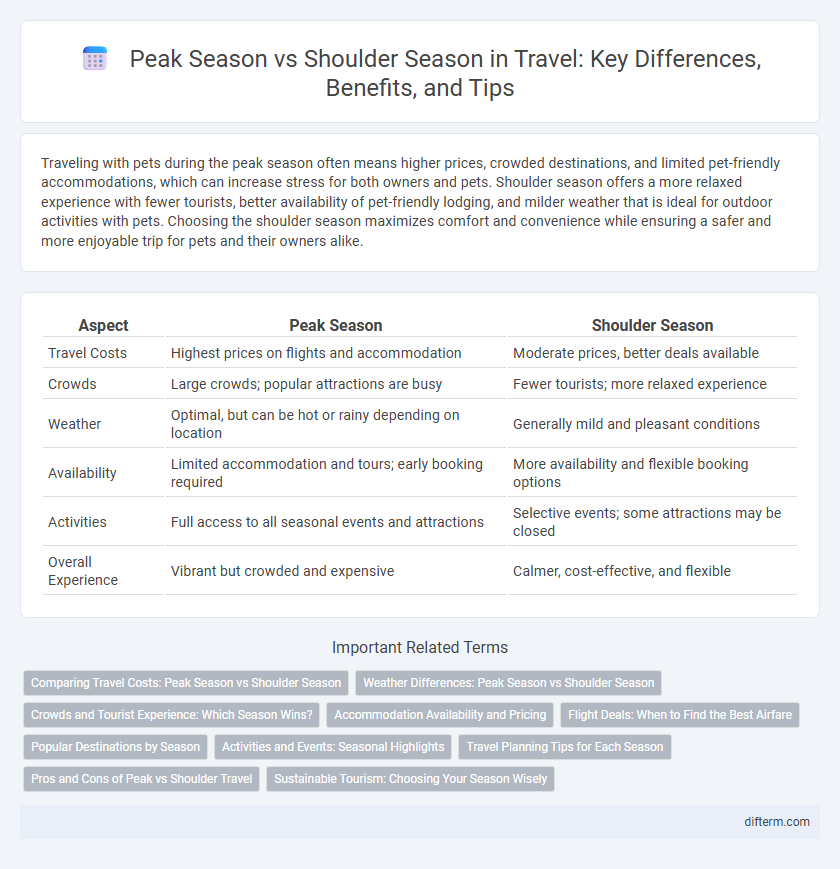Traveling with pets during the peak season often means higher prices, crowded destinations, and limited pet-friendly accommodations, which can increase stress for both owners and pets. Shoulder season offers a more relaxed experience with fewer tourists, better availability of pet-friendly lodging, and milder weather that is ideal for outdoor activities with pets. Choosing the shoulder season maximizes comfort and convenience while ensuring a safer and more enjoyable trip for pets and their owners alike.
Table of Comparison
| Aspect | Peak Season | Shoulder Season |
|---|---|---|
| Travel Costs | Highest prices on flights and accommodation | Moderate prices, better deals available |
| Crowds | Large crowds; popular attractions are busy | Fewer tourists; more relaxed experience |
| Weather | Optimal, but can be hot or rainy depending on location | Generally mild and pleasant conditions |
| Availability | Limited accommodation and tours; early booking required | More availability and flexible booking options |
| Activities | Full access to all seasonal events and attractions | Selective events; some attractions may be closed |
| Overall Experience | Vibrant but crowded and expensive | Calmer, cost-effective, and flexible |
Comparing Travel Costs: Peak Season vs Shoulder Season
Peak season travel costs surge due to high demand, with airfare and accommodation prices rising by up to 50% compared to shoulder season rates. Shoulder season offers significantly lower prices, often 20-40% cheaper, providing budget-conscious travelers access to popular destinations with fewer crowds. Choosing shoulder season travel optimizes expenses while maintaining favorable weather and accessibility.
Weather Differences: Peak Season vs Shoulder Season
Peak season typically features stable, warm weather with minimal rainfall, ideal for beach vacations and outdoor activities. Shoulder season offers milder temperatures and fewer crowds, but weather can be more unpredictable with occasional rain showers. Travelers seeking a balance between pleasant weather and cost savings often prefer shoulder season despite its variable conditions.
Crowds and Tourist Experience: Which Season Wins?
Peak season typically draws larger crowds with bustling attractions and lively events, offering a vibrant but often congested tourist experience. Shoulder season provides a more relaxed atmosphere with fewer tourists, allowing for easier access to sites, shorter wait times, and enhanced enjoyment of local culture. Choosing shoulder season often results in a more peaceful and authentic travel experience, especially for visitors seeking to avoid overcrowding.
Accommodation Availability and Pricing
Accommodation availability significantly decreases during peak season due to high tourist demand, resulting in limited options and increased prices. In contrast, shoulder season offers greater accommodation availability with more competitive pricing, allowing travelers to access quality lodging at lower rates. Booking during shoulder season often provides a balance between cost savings and comfortable stay options.
Flight Deals: When to Find the Best Airfare
Flights during shoulder season typically offer the best airfare, as airlines lower prices to attract travelers between peak demand periods. In contrast, peak season flights often come with higher fares due to increased passenger volume and limited seat availability. Booking during shoulder season balances favorable weather conditions with cost savings on airfare, making it an ideal time for budget-conscious travelers.
Popular Destinations by Season
Popular destinations like Paris and Rome see their peak season from June to August, attracting tourists with warm weather and numerous outdoor events. During shoulder seasons in spring and fall, these cities offer fewer crowds, moderate prices, and pleasant weather, ideal for cultural exploration and local experiences. Coastal areas such as Bali peak during July and August, while shoulder seasons provide better deals and less congestion, enhancing relaxation and discovery.
Activities and Events: Seasonal Highlights
Peak season offers a wide array of activities and events such as music festivals, cultural parades, and outdoor sports that cater to large crowds seeking vibrant experiences. Shoulder season provides a more relaxed atmosphere with unique local events, nature hikes, and seasonal food markets that highlight regional traditions without the bustling tourist influx. Travelers can enjoy optimal weather conditions in both seasons but benefit from more personalized and less crowded experiences during the shoulder season.
Travel Planning Tips for Each Season
Travel planning during peak season requires early booking and flexibility to secure accommodations and activities amidst high demand and elevated prices. In contrast, shoulder season offers moderate weather and fewer crowds, allowing travelers to enjoy popular destinations with better deals and more personalized experiences. Prioritizing destination-specific weather patterns and local events helps maximize enjoyment and cost-efficiency in both peak and shoulder seasons.
Pros and Cons of Peak vs Shoulder Travel
Traveling during peak season offers vibrant cultural events, better weather, and fully operational tourist attractions, but it often involves higher costs, crowded destinations, and limited accommodation availability. Shoulder season travel provides a balance of moderate weather and fewer tourists, resulting in lower prices and a more relaxed experience, though some services might be reduced and weather can be less predictable. Choosing between peak and shoulder seasons depends on priorities like budget, crowd tolerance, and desired activities.
Sustainable Tourism: Choosing Your Season Wisely
Traveling during the shoulder season reduces environmental impact by minimizing overcrowding and decreasing strain on local resources compared to peak season. Sustainable tourism encourages selecting periods with fewer tourists to support local economies year-round and preserve natural habitats. Planning trips in shoulder seasons promotes responsible travel practices that balance enjoyment with ecological conservation.
peak season vs shoulder season Infographic

 difterm.com
difterm.com